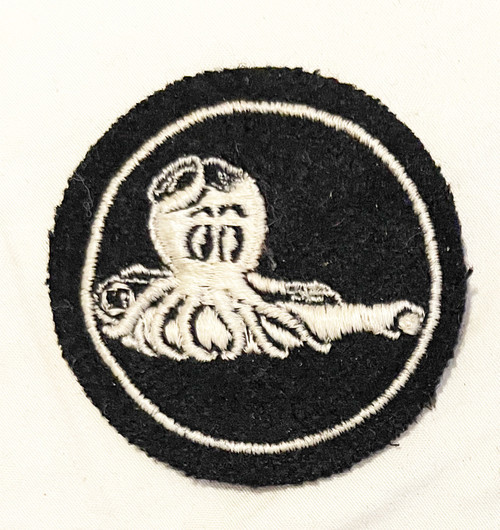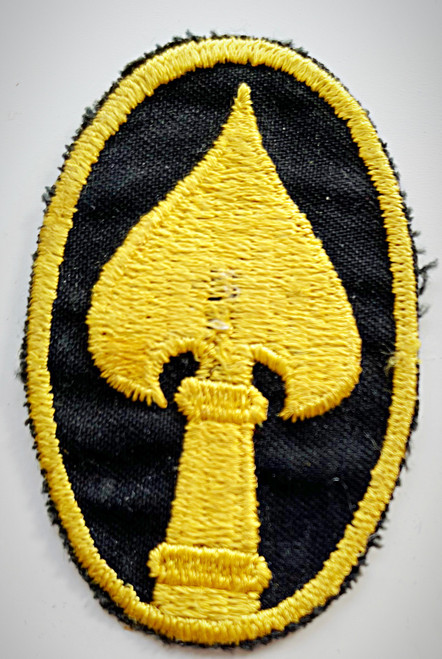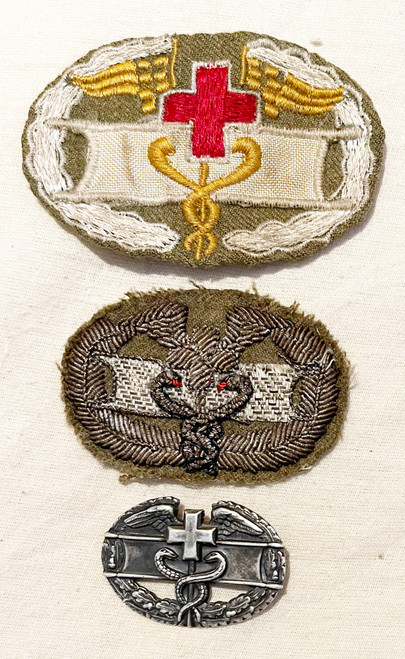2 black and white one colour one pin net tenders patches
The research of Lester Tucker (W-4,
U.S. Navy, Ret.) turned up some documen-
tation regarding two familiar, though verv
scarce, Navy enlisted distinguishing marks
that help to define their origins, previously
mysteries to collectors of Navy insignia.
The Navy never authorized the first of
thest.
Harbor Net Tender. The second
Armed Guard, was briefly authorized and
verified original
samples are virtually un-
knoWn.
The following provides us with a
glimpse of the history behind these two
distinguishing marks.
Harbor Net Tender
Figure 1. Drawing and sample patch from enclosure for Harbor Net Tender request.
The commanding officer of the l
Navy Net Depot at Portsmouth (Melville),
rized agents, of badges which have not
R. sent a request to the Chief. Bureau of
been approved by the Secretary of the
Personnel, dated 18 January 1943, seeking
avy.
approval of a "Sleeve Insignia for Enlisted
Figures 2 and 3 are of such unautho-
Personnel.
The request had an enclosure
rized "badges" predicted by the response
of a drawing and an attached samole patch
and reflect a foresight that insignia collec
navy blue cloth of the proposed item
tors of all services recognize as a very ac
(Figure 1). The description defining diam-
curate assescmen
eter of 2" with
"…. white silk insignia of an
octopus with tentacles around subn
» and having an outer eage
of 1/8
of the base cloth surrounding a white em-
proldered norder.
The Bureau of Naval Personnel had
been through an unflux of requests for sumi.
lar insignia for activities of relatively small
populations: Air Gunner approved in Feb-
ruary, Airship Insignia, Armed Guard and
Mine Assemblyman 1n March. The resolv
to this request would seem to reflect a re
action to potential continued prolleration
with the respolsy.
"It is the desire of the
Bureau of Naval Personnel to simplify,
rather than elaborate. on the unitorms of
the enlisted personnel of the U. S. Navy. It
Figure 2
Harbor Net lender patch
Mioure ?
Charbor
Net lender patch variant
believed to be of west coast origin (courtesy
or steve an nson.
Armodluara
wearing of special distinguishing marks DV
men who have received training in anti-sub
marine and torpedo nets.
The
response also includes a
I callon
10 omner commanas inau
.In the ruture
When designs are submitted for approval.
thev be submitted as drawmas. and that
no embroidered badges be made up. In nu
instances, the later practice
has…resulted in the issuance, by unauthc
TRADING POST
Of those other
distinguishing marks
listed above, that for Armed Guard had been
approved in a Bureau of Personnel Circular
Letter No. 28-43 dated 10 March 1943. This
was initiated ov a request trom the com-
manding oflicer; Armed G
uard School dated
29 January 1943 proposing, "...
an insignia
suggested for use of the Armed Guard Ser.
vice."4 The Armed Guard Service provided
units of Navv
SOCI
•sonnel to man defensive
armament on merchant vessels transnort
ing men and materials across the ocean ex-
ballots.
In the request. it was proposed
that the "
...insigna be made at the Naval
Clothing Factories…..to be












